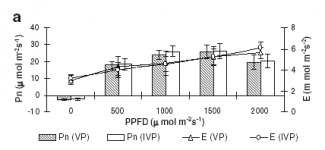SupraSPL
Member
Hi Avenger, thanks for the encouragement. So the only difference between PPF and PPFD is that inclusion of a distance. The "per second" part was throwing me off. They are both measured per second, which is why KNNA wrote "per second of course" when he mentioned it on CC.net. I think I am on board now 
For sure, he has said that red/blue works well for vegging but that red/white/blue works best for flowering.
I agree. KNNA made an interesting point in this thread. We understand that individual photons are what drive photosynthesis. Blue photons are much more power hungry and the effect really adds up:
KNNA wrote:
"A photon's energy is inversely proportional to its wavelenght. So a PAR Watt of 450nm carries 450/650=69% photons than a PAR Watt of 650nm. Or said based on the red photons, a Watt of 650nm carries 650/450=44% more photons than a 450nm Watt. UIts a large difference that advices to use uE instead of Watts.
For example, you have a 30% efficient red LED (638nm peak) and a 38% efficient blue LED (450nm peak). This a valid example of max today's efficiencies (commercialy avalaible)of both colors. While the blue emits 380mW for each watt burned, and the red only 300mW, the blue emits 1.216 uE/s while the red emits 1.542 uE, due each blue photon carries more energy."
When considering energy efficiency, we can certainly benefit from this understanding when tuning the spectrum.
This is a bit of an old theory. I am sure KNNA knows that you can not grow anything of quality under monochromatic 660nm light.
For sure, he has said that red/blue works well for vegging but that red/white/blue works best for flowering.
To what extent or percentage the tuned spectrum can reduce the required PPFD is more than a guessing game, and all the claims by LED light manufacturers so far have been way too optimistic and not based in fact.
I agree. KNNA made an interesting point in this thread. We understand that individual photons are what drive photosynthesis. Blue photons are much more power hungry and the effect really adds up:
KNNA wrote:
"A photon's energy is inversely proportional to its wavelenght. So a PAR Watt of 450nm carries 450/650=69% photons than a PAR Watt of 650nm. Or said based on the red photons, a Watt of 650nm carries 650/450=44% more photons than a 450nm Watt. UIts a large difference that advices to use uE instead of Watts.
For example, you have a 30% efficient red LED (638nm peak) and a 38% efficient blue LED (450nm peak). This a valid example of max today's efficiencies (commercialy avalaible)of both colors. While the blue emits 380mW for each watt burned, and the red only 300mW, the blue emits 1.216 uE/s while the red emits 1.542 uE, due each blue photon carries more energy."
When considering energy efficiency, we can certainly benefit from this understanding when tuning the spectrum.



